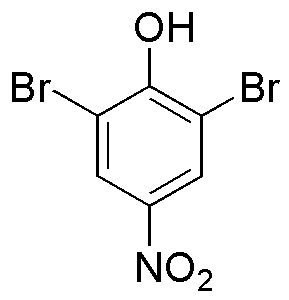2,6-Dibromo-4-nitrophenol is widely utilized in research focused on:
- Analytical Chemistry: This compound serves as a reagent for the detection and quantification of various substances in environmental samples, aiding in pollution monitoring.
- Pharmaceutical Development: It is used in the synthesis of pharmaceutical intermediates, contributing to the creation of new medications with improved efficacy.
- Material Science: The compound is incorporated into polymer formulations to enhance thermal stability and flame retardancy, making materials safer for various applications.
- Biological Research: It acts as a biological probe in studies investigating enzyme activity and cellular processes, helping researchers understand complex biological systems.
- Agricultural Chemistry: This chemical is utilized in the development of agrochemicals, providing solutions for pest control while minimizing environmental impact.
General Information
Properties
Safety and Regulations
Applications
2,6-Dibromo-4-nitrophenol is widely utilized in research focused on:
- Analytical Chemistry: This compound serves as a reagent for the detection and quantification of various substances in environmental samples, aiding in pollution monitoring.
- Pharmaceutical Development: It is used in the synthesis of pharmaceutical intermediates, contributing to the creation of new medications with improved efficacy.
- Material Science: The compound is incorporated into polymer formulations to enhance thermal stability and flame retardancy, making materials safer for various applications.
- Biological Research: It acts as a biological probe in studies investigating enzyme activity and cellular processes, helping researchers understand complex biological systems.
- Agricultural Chemistry: This chemical is utilized in the development of agrochemicals, providing solutions for pest control while minimizing environmental impact.
Documents
Safety Data Sheets (SDS)
The SDS provides comprehensive safety information on handling, storage, and disposal of the product.
Product Specification (PS)
The PS provides a comprehensive breakdown of the product’s properties, including chemical composition, physical state, purity, and storage requirements. It also details acceptable quality ranges and the product's intended applications.
Certificates of Analysis (COA)
Search for Certificates of Analysis (COA) by entering the products Lot Number. Lot and Batch Numbers can be found on a product’s label following the words ‘Lot’ or ‘Batch’.
*Catalog Number
*Lot Number
Certificates Of Origin (COO)
This COO confirms the country where the product was manufactured, and also details the materials and components used in it and whether it is derived from natural, synthetic, or other specific sources. This certificate may be required for customs, trade, and regulatory compliance.
*Catalog Number
*Lot Number
Safety Data Sheets (SDS)
The SDS provides comprehensive safety information on handling, storage, and disposal of the product.
DownloadProduct Specification (PS)
The PS provides a comprehensive breakdown of the product’s properties, including chemical composition, physical state, purity, and storage requirements. It also details acceptable quality ranges and the product's intended applications.
DownloadCertificates of Analysis (COA)
Search for Certificates of Analysis (COA) by entering the products Lot Number. Lot and Batch Numbers can be found on a product’s label following the words ‘Lot’ or ‘Batch’.
*Catalog Number
*Lot Number
Certificates Of Origin (COO)
This COO confirms the country where the product was manufactured, and also details the materials and components used in it and whether it is derived from natural, synthetic, or other specific sources. This certificate may be required for customs, trade, and regulatory compliance.


